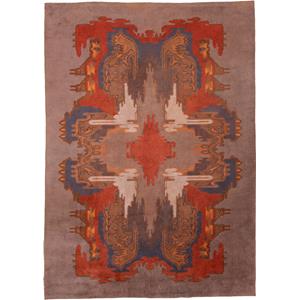IMAGE DETAILS

N. Vrouyr
Jaap Gidding (Rotterdam 1887-1955 Hillegersberg) rug
Design by Jaap Gidding in the style of Tuschinski, 1920
Warp and weft: cellulose, pile: wool, asymmetrical knot
390 x 290 cm
Handknotted in the 'Koninklijke Vereenigde Tapijtfabrieken'
The Amsterdamse School deeply influenced the revival of the Dutch textile industry on the eve of WWI. Creativity and craftsmanship explored new possibilities and launched refreshing trends. The projects were closely inspired by nature and often produced stylized floral designs. Although one cannot deny there is an obvious link with the other European schools, the Dutch style is very easy to recognize.
Produced in the workshops of KVT (Koninklijke Vereenigde Tapijtfabrieken Rotterdam, Amsterdam, Deventer, Moordrecht). KVT opened in 1797. One of their aims was to create new jobs in a rather poor neighborhood and very quickly prospered into an important
industry. The factory closed down in 1978.
Jaap Gidding (Rotterdam, 10 May 1887 - Hillegersberg, 23 April 1955) was a Dutch designer. He was active as a draughtsman, painter, glass painter, wall painter, decoration painter (of interiors), ceramicist, goldsmith, jewelry designer, interior designer, monumental artist, textile artist, and maker of mosaic. Gidding is best known for designing wall decorations for cinemas and ships. For example, he designed the large rug in the central hall of the Tuschinski theatre in Amsterdam, but also the decoration of the Trianon cinema in Leiden. More rugs in this style have been knotted similar to the one presented at Brafa 2024. One piece is at the textile museum in Tilburg.



 download image
download image